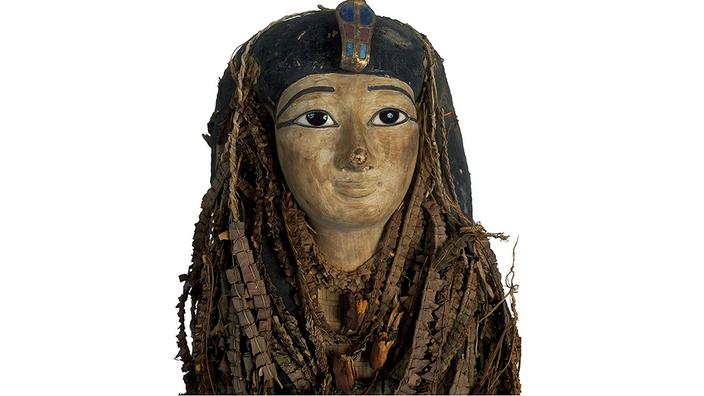Amenhotep I, the second pharaoh of the prestigious 18th dynasty of Egypt, has found his face again, 140 years after the discovery of his mummy in Luxor.
A CT scan campaign conducted by Cairo University allowed this fall to reveal the features of the sovereign, hitherto hidden under his strips, and to highlight his similarities with those of his father, the Pharaoh Ahmose I. .
But also with the face painted on his coffin, in which the pharaoh was reburied, nearly five centuries after his death.
Read also: Entry of mortuary ropes, a pre-Inca mummy discovered in an ancient city of Peru
One of the rare royal mummies of Egypt not to have been laid bare, the remains of the pharaoh have never been directly observed by Egyptologists in order to preserve his beautiful funerary casing as well as the garlands of flowers - safflower, gum trees, dolphinels - which surround her, like her colorful hair. Considerations that ancient grave robbers did not have.
“The CT images show the extent of damage to the mummy of Amenhotep I, including neck fractures and decapitation, a large gash in the anterior abdominal wall and disarticulation of the extremities (left upper limb, right hand and right foot)",
indicate the radiologist Sahar Saleem (Cairo University) and the controversial archaeologist - former Minister of Antiquities under Hosni Mubarak - Zahi Hawass, in a study published Tuesday in the scientific journal
Frontiers in Medicine
.
Egyptian scientists were able to reconstruct the face of Pharaoh Amenhotep I.
But also to determine that this sovereign of the XVIIIth dynasty was the subject of much care several centuries after his death.
Egyptian Ministry of Antiquities / AFP
Outraged, the mummy of Amenhotep was however reembalmed under the XXIst Dynasty, five centuries after the death of the pharaoh.
This conservation work was carried out with great care by the priests in charge of the operation, the researchers noted, noting in particular that 30 new protective amulets.
Various jewels were slipped among the bands of the deceased, in particular at the level of his wounds inflicted during the looting of his grave.
The coffin itself has been carefully designed.
Polychrome, it was notably encrusted with obsidian to form the eyes of the portrait of the deceased.
A rather similar portrait, according to mummy specialists.
Read alsoEgypt lavishly inaugurates the restoration of the Alley of the Sphinxes in Luxor
See without destroying
Egyptologists, however, did not just stare at the pharaoh. Unlike the founder of the dynasty, Amenhotep, for example, was mummified with his arms folded in a cross over his chest. A common pose during the New Egyptian Empire, and whose mummy has the oldest documented occurrence, said Tuesday, in a statement from the Egyptian Ministry of Antiquities, Zahi Hawass. In addition, the priests did not "update" the mummification of the Pharaoh to bring it up to the standards of Egyptian practices of the 11th - 10th century. The royal remains would thus be the last of its time to keep its brain, systematically removed from the reign of its successor, Thutmose I.
The mummy of Amenhotep I would present one of the last examples of non-excerebration (removal of the brain) during the mummification of the remains.
Egyptian Ministry of Antiquities / AFP
Son of Ahms-Nefertari and Ahmosis I, Amenhotep I, would have reigned for 21 years, between 1525 and 1504 BC.
AD, at a stable and relatively opulent period of Egyptian history.
He is said to have died at 35, under poorly understood circumstances.
Discovered in a royal cache, near Luxor, alongside other princes and sovereigns, his coffin presented a cartouche whose hieroglyphs recapitulated the process of conservation and protection carried out by priests of the XXIst dynasty.
The location of the pharaoh's original tomb is not known.
Read also In Cairo, the City of the Dead in Danger due to a road extension
The study carried out by Sahar Saleem and Zahi Hawass on the mummy of Amenhotep is part of a long research program carried out under the aegis of the Egyptian Ministry of Antiquities and relating to a general analysis of the mummies by CT scan.
Also known under the name of computed tomography, the technique consists of having the mummies studied under a medical scanner and thus auscultating these very fragile bodies as closely as possible, reducing the risk of deterioration.
And, in the case of Amenhotep, not to damage his coffin.
The precise causes of the death of the Pharaoh, however, could not be established during the study.
Using this same technique, Zahi Hawass and Albert Zink, the German specialist in mummies, in 2012 solved a 3000-year-old crime by uncovering the truth about the “
harem conspiracy
”.
With the help of X-rays and DNA analyzes, they had proved that Ramses III had his throat slit after a plot hatched by one of his wives.
The intriguing wanted to install, by this gesture, her son on the throne in place of the firstborn of one of her rivals.
A scheme which ultimately failed with the succession of the Pharaoh's legitimate son, Ramses IV.

